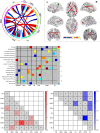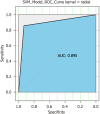Identification of key brain networks and functional connectivities of successful aging: A surface-based resting-state functional magnetic resonance study
- PMID: 40110011
- PMCID: PMC11886311
- DOI: 10.5498/wjp.v15.i3.100456
Identification of key brain networks and functional connectivities of successful aging: A surface-based resting-state functional magnetic resonance study
Abstract
Background: Successful aging (SA) refers to the ability to maintain high levels of physical, cognitive, psychological, and social engagement in old age, with high cognitive function being the key to achieving SA.
Aim: To explore the potential characteristics of the brain network and functional connectivity (FC) of SA.
Methods: Twenty-six SA individuals and 47 usual aging individuals were recruited from community-dwelling elderly, which were taken the magnetic resonance imaging scan and the global cognitive function assessment by Mini Mental State Examination (MMSE). The resting state-functional magnetic resonance imaging data were preprocessed by DPABISurf, and the brain functional network was conducted by DPABINet. The support vector machine model was constructed with altered functional connectivities to evaluate the identification value of SA.
Results: The results found that the 6 inter-network FCs of 5 brain networks were significantly altered and related to MMSE performance. The FC of the right orbital part of the middle frontal gyrus and right angular gyrus was mostly increased and positively related to MMSE score, and the FC of the right supramarginal gyrus and right temporal pole: Middle temporal gyrus was the only one decreased and negatively related to MMSE score. All 17 significantly altered FCs of SA were taken into the support vector machine model, and the area under the curve was 0.895.
Conclusion: The identification of key brain networks and FC of SA could help us better understand the brain mechanism and further explore neuroimaging biomarkers of SA.
Keywords: Functional connectivity; Resting-state functional magnetic resonance imaging; Successful aging; Support vector machine algorithm; Surface-based brain network analysis.
©The Author(s) 2025. Published by Baishideng Publishing Group Inc. All rights reserved.
Conflict of interest statement
Conflict-of-interest statement: All the authors report no relevant conflicts of interest for this article.
Figures



Similar articles
-
Preliminary Analysis of Volume-Based Resting-State Functional MRI Characteristics of Successful Aging in China.J Alzheimers Dis. 2023;91(2):767-778. doi: 10.3233/JAD-220780. J Alzheimers Dis. 2023. PMID: 36502325
-
[Correlations between Hippocampus and Cognitive Score in Patients with Carotid Artery Stenosis Based on Resting State Functional Magnetic Resonance Imaging].Zhongguo Yi Xue Ke Xue Yuan Xue Bao. 2022 Dec;44(6):980-989. doi: 10.3881/j.issn.1000-503X.14737. Zhongguo Yi Xue Ke Xue Yuan Xue Bao. 2022. PMID: 36621787 Chinese.
-
[Resting state fMRI study of emotional network in patients with postconcussion syndrome].Zhonghua Yi Xue Za Zhi. 2017 Jul 4;97(25):1951-1955. doi: 10.3760/cma.j.issn.0376-2491.2017.25.007. Zhonghua Yi Xue Za Zhi. 2017. PMID: 28693073 Chinese.
-
Resting-state functional magnetic resonance imaging and support vector machines for the diagnosis of major depressive disorder in adolescents.World J Psychiatry. 2024 Nov 19;14(11):1696-1707. doi: 10.5498/wjp.v14.i11.1696. eCollection 2024 Nov 19. World J Psychiatry. 2024. PMID: 39564181 Free PMC article. Review.
-
Effect of acupuncture on brain regions modulation of mild cognitive impairment: A meta-analysis of functional magnetic resonance imaging studies.Front Aging Neurosci. 2022 Sep 23;14:914049. doi: 10.3389/fnagi.2022.914049. eCollection 2022. Front Aging Neurosci. 2022. PMID: 36212046 Free PMC article.
References
LinkOut - more resources
Full Text Sources

